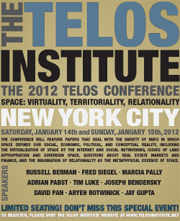This paper was presented at the 2012 Telos Conference, “Space: Virtuality, Territoriality, Relationality,” held on January 14–15, in New York City.
I shall argue for a distinction made between two concepts of centrality. Both are rather metaphorical but whereas the first is best captured by a concrete symbol, the heart, the second is more abstract and geometrical, to be captured as the “line between.”
 I further try to show how they may be interpreted as representations of two strands in the political or, more generally, in the collective thinking of the Western tradition. By referring to collective thinking, I wish to broaden the usually highly abstract perspective of academic political philosophy. For such thinking is scarcely done in scientific terms and concepts but more often in metaphors, images, symbols. Thomas Hobbes was very much aware that the concept of the sovereign needs a powerful image to understand, and he instructed Abraham Bosse how to design it. The resulting title page of the book, with Leviathan, the mortal god, is perhaps a better argument than half a dozen pages from the same book. In times of prevalent illiteracy, images, pictures, statues, coats of arms, costumes, and dynamic images like processions and marches have been an even more important source of inspiration and explanation in collective thinking.
I further try to show how they may be interpreted as representations of two strands in the political or, more generally, in the collective thinking of the Western tradition. By referring to collective thinking, I wish to broaden the usually highly abstract perspective of academic political philosophy. For such thinking is scarcely done in scientific terms and concepts but more often in metaphors, images, symbols. Thomas Hobbes was very much aware that the concept of the sovereign needs a powerful image to understand, and he instructed Abraham Bosse how to design it. The resulting title page of the book, with Leviathan, the mortal god, is perhaps a better argument than half a dozen pages from the same book. In times of prevalent illiteracy, images, pictures, statues, coats of arms, costumes, and dynamic images like processions and marches have been an even more important source of inspiration and explanation in collective thinking.







